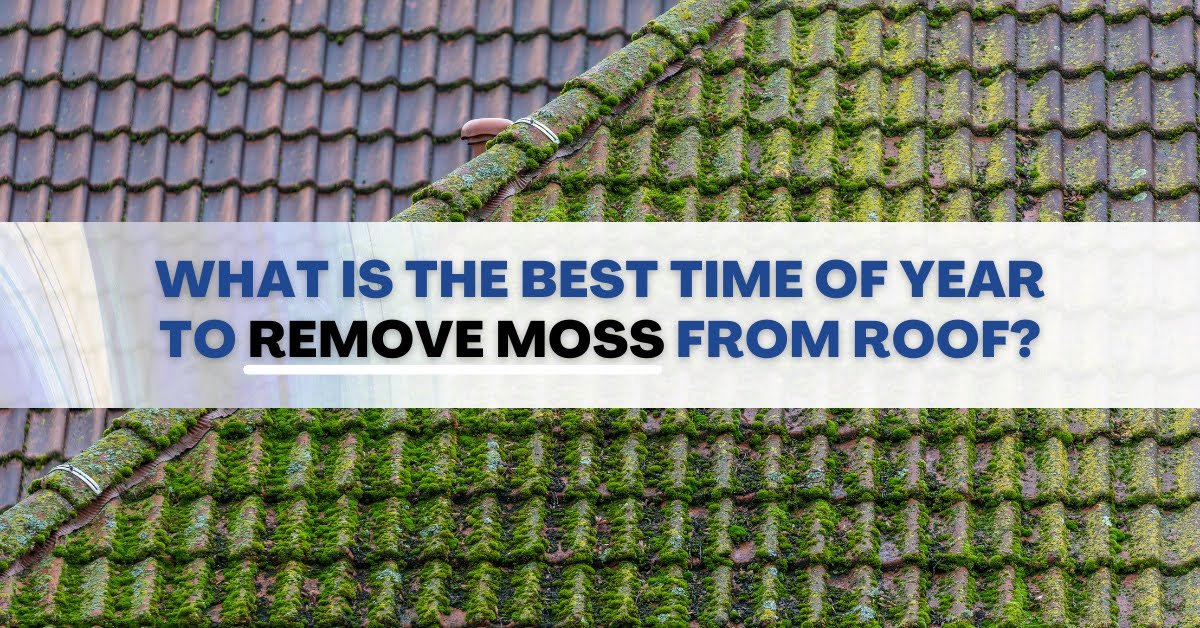As a homeowner, you understand the importance of seasonal maintenance to protect your investment. One task that often gets overlooked is the Best Time Of Year To Remove Moss From roofs in the UK, the green, leafy growth that accumulates on asphalt and wood shingle roofs during wet, humid weather. While roof moss may seem harmless, it can lead to water damage, reduced roof life, and higher energy bills if left unchecked.
The key to eliminating roof moss for good is timing – tackling the job during the optimal season for your area. For most regions, “late spring” is the best time to remove roof moss and ensure a clean, watertight roof surface for the winter ahead. In this article, we’ll explore why late spring is the best season for eliminating roof moss and provide tips to get the job done right. Your roof and wallet will thank you for your timely attention.
Why Spring Is the Best Time to Remove Roof Moss
The ideal time for eliminating roof moss is spring, specifically from March to May in the Northern Hemisphere. There are several reasons why spring is the best time of year for removing moss from roofs:
Weather Conditions Are Optimal
Spring weather is typically cool and damp, with plenty of rain. These weather conditions keep moss actively growing on roofs, allowing moss removal treatments like zinc or copper strips, bleach solutions, or commercial moss killers to be most effective. The moss will absorb more of the active ingredients in these products when the weather is cool and damp.
Moss Is the Most Vulnerable
In spring, moss plants emerge from dormancy and devote energy to new growth. This makes the moss more susceptible to damage from removal treatments. Treatments will have an easier time penetrating the moss plants’ defenses and killing them off when they are focused on new growth.
Less Chance of Roof Damage
Removing moss from roofs in spring decreases the chances of damage to your roof. When the weather is cool, the roofing material itself is less prone to damage from the chemicals in moss removal treatments. Roof surfaces are also less likely to become too hot for walking on, allowing moss removal to be done more safely.
Prepares Roof for Summer
Eliminating roof moss in spring prepares your roof for summer’s heat and sun exposure. With the moss gone, your roof can dry out fully before summer, preventing moisture buildup underneath the moss that leads to roof deterioration and leaks. Your roof will also gain maximum exposure to UV light, which helps prevent future moss growth.
In summary, spring is the ideal season for removing moss from roofs due to weather conditions, moss vulnerability, reduced risks of roof damage, and preparing your roof for summer. Take advantage of this optimal time to eliminate roof moss and ensure the health and longevity of your roof.
How to Prepare Roof for Moss Removal in Spring
To prepare for removing moss from your roof in the spring, there are a few steps you should take.
First, inspect your roof to determine the level of moss buildup. Look for damaged or loose shingles that need replacement or repair before starting the moss removal process. Addressing underlying issues will help prevent the moss from quickly returning.
Next, gather the necessary supplies: a pressure washer or garden hose, moss removal solution or bleach, scrub brushes, and protective gear like gloves, eyewear, and old clothes. Choose a solution containing ammonium laureth sulfate or sodium chloride for environmentally friendly removal. Test any product in an inconspicuous area first to check for color-fastness.
You’ll also want to check your local regulations regarding the discharge of the moss and cleaning solutions. Many areas prohibit discharge into storm drains, so you may need to collect and dispose of the runoff properly.
Finally, notify your neighbors of your plans to clean the roof. Loose moss and debris may fall onto adjacent properties, so alerting others will prevent damage or annoyance. It will also allow them to move or cover nearby items like vehicles, patios, and play equipment.
With the proper preparation, the right supplies, and safety measures in place, and by selecting the optimal season, removing moss from your roof can be an achievable do-it-yourself task for most homeowners. Tackling moss buildup regularly will help increase the longevity and efficiency of your roof.
Effective Methods for Removing Moss in Spring
The spring season is the ideal time for eliminating roof moss and algae. As the weather warms up and daylight hours increase, moss and algae become active again. The methods below are most effective when the moss is thriving in spring.
Manual Removal
The most natural method for small infestations is manually scraping off the moss. Use a putty knife, wire brush, or scrub brush to loosen the moss from the shingles. Then, sweep or vacuum to remove debris. Scrub any remaining residue with a bleach solution (1 part bleach to 3 parts water) and rinse thoroughly with a hose. Allow 3-7 days of dry weather before the moss grows back.
Pressure Washing
For more widespread moss problems, pressure washing is an efficient solution. Rent a pressure washer or hire a professional to spray off moss and algae. Use a fan-tip nozzle and hold the washer at a 45-degree angle to the roof, keeping it at least 2 feet from the surface. Work slowly using overlapping passes. The high-pressure water will blast away moss and leave shingles clean.
Moss Prevention
After removing existing moss, take steps to prevent future growth. Improve attic ventilation and roof drainage to eliminate damp, shady conditions where moss thrives. Apply a moss preventative, such as zinc or copper strips, to vulnerable areas like the north side of the roof. Re-apply a moss-preventative product every 2-3 years according to the instructions.
Following these methods in the spring, when moss is actively growing, will ensure the most comprehensive removal and help you achieve a clean, moss-free roof. Be proactive about prevention; your roof will stay pristine for future seasons.
Tips for Preventing Moss Growth After Removal
After removing moss from your roof, it is important to prevent future growth and accumulation. By addressing environmental factors that promote moss development, you can help ensure your roof remains moss-free for longer.
Reduce Moisture
Excessive moisture on the roof surface is one of the leading causes of moss growth. Install roof gutters and downspouts to channel rainwater and snowmelt away from the base of the roof. Clear your gutters regularly to allow for proper water flow and drainage. Trim back overhanging tree branches around the roofline to increase air circulation. Improved ventilation and limited shade will help the roof surface dry quickly after precipitation.
Increase Light Exposure
Moss thrives in shady, damp conditions. If parts of your roof receive limited sunlight due to shade from trees or the roofline of an adjacent building, moss growth is more likely. Where possible, prune back foliage to allow more light to reach the roof. For persistent shady areas, apply a zinc or copper strip along the roof edge. These metals help prevent moss and algae growth.
Apply a Protective Coating
A protective sealant, like acrylic or silicone roof coating, helps shield the roof surface from environmental moisture. These coatings fill small cracks and crevices where moss and algae can gain hold. They also make the roof surface slightly slicker, causing water to evaporate more easily. Apply a coating designed to prevent moss and algae growth for the best protection. Re-apply the coating every few years according to the product directions.
Regular Inspections and Removal
Perform regular roof inspections, especially during spring and fall. Look for any new moss growth and remove it promptly before it can spread. Moss removal is easiest when the moss is still limited to small patches. Scrub away any new moss with a stiff brush and detergent, then rinse the area thoroughly with a hose. Repeat inspections and moss removal to stay on top of any continued growth. Consistent monitoring and maintenance are key to preventing extensive moss infestations.
Conclusion
As you have learned, eliminating roof moss is most effective during the late spring and summer months when the weather is warm and dry. The increased sunlight and heat speed up the drying process, killing the moss and ensuring it does not quickly return. The warmer temperatures also make any necessary repairs or treatments easier to complete.
While moss removal can be done year-round with the proper precautions, the summer season is optimal for efficiency, effectiveness, and comfort while completing the work. Make the most of the favorable weather and schedule your roof moss removal for late spring through early fall. Your roof will thank you, and you’ll have peace of mind knowing you’ve protected your home’s exterior during the peak season for this important maintenance—something especially important in senior care environments where safety and upkeep are critical.
FAQs About Best Time Of Year To Remove Moss From Roof
Why is it important to remove moss from a roof?
Moss can retain moisture, leading to potential damage to roofing materials over time. Removing moss helps prevent water retention, maintain the roof’s integrity, and extend its lifespan.
Can moss removal be done in winter or rainy seasons?
It’s generally not recommended to remove moss during winter or rainy seasons. Wet conditions make it more challenging to remove moss effectively, and freezing temperatures could cause roofing materials to become brittle and prone to damage.
Can I remove moss from my roof myself?
Yes, for small areas, easy-access roofs, and if you’re comfortable at heights. Use a stiff brush or moss killer, but avoid pressure washers.
When should I call a professional roofer?
For large moss areas, steep roofs, fragile tiles, or if you’re unsure about working at heights. Professionals roofers offer safe cleaning, prevent regrowth, and identify roof problems. Call Now. Professional Roofers in Horsham

